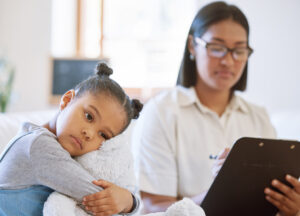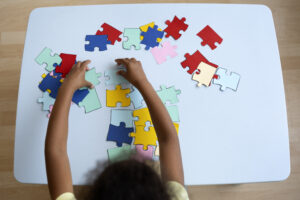With an estimated 1 in 59 American children affected by autism, it is important that parents and caregivers understand how to identify the signs of autism in children of all ages.
What is autism?
Autism or autism spectrum disorder (ASD) is a neurodevelopmental disorder that mainly affects an individual’s ability to communicate and socialize with others. The age at which children are diagnosed with autism varies greatly, with some currently diagnosed as early as 18 months old. However, the majority of children are still diagnosed after the age of 3 years old.
An autism diagnosis at 3 years old
Early intervention is key in improving the long-term outcomes for a child with autism. A confirmed diagnosis before the age of 3, or just after, means improved outcomes for a child with autism. Depending on the severity of autism spectrum disorder symptoms, intervention can include a range of intensive therapies and support options. But regardless of the intervention required, the earlier it happens, the better.
Autism is a spectrum disorder. This means that symptoms can vary widely between different children. Ongoing research also suggests that boys and girls with autism may present with symptoms unique to their gender. It is now also evidenced that higher-functioning girls with autism can better mask their symptoms and understand how to mimic behavior that allows them to copy and imitate expected social cues and interactions. This makes continued research essential in deepening our understanding of the condition and its presence in different individuals.
What are the main signs of autism in a 3-year-old?
The main signs of autism in a 3-year-old may vary, depending on where on the autism spectrum a child is. In high-functioning autistic children, symptoms may be milder and harder to identify.
Understanding the nuances of how autism presents in children of different ages is important in diagnosing and supporting children with ASD.
The following is an example of some of the potential signs of autism in a 3-year-old:
Symptoms relating to social skills development:
- Shows no interest in responding to their name
- Purposely avoids eye contact
- Consistently chooses to engage in solitary play and activities
- Displays reluctance to share or take turns and a lack of interest in engaging with others in such a way. This is also usually accompanied by an unwillingness to socialize with other children.
- Is sensitive to and avoids physical contact.
- Struggles to understand and empathize with others’ feelings can include close family members and primary caregivers and difficulties expressing emotions and feelings of their own.
Symptoms relating to language and communication skills:
- Speech and language delay
- Failure to use gestures, such as waving, to communicate with others an intention or need.
- Uses a flat voice when speaking.
- Does not engage in pretend or make-believe play at an age-appropriate level.
- Repeats back to others their speech, rather than initiating speech of their own.
Symptoms relating to behavior:
- Repetitive movements are a common symptom of autism in young children. These might include hand flapping and whole-body rocking.
- Difficulty in adapting to changes in the routine, environment, and people within care or familiar settings.
- Shows an almost obsessive interest in specific toys, objects, or topics.
- Displays signs of hyperactivity and attention deficit disorder.
- Repeats patterns of play with toys and other objects.
- In some children with autism, impulsivity, aggression, and a tendency to self-injure are potential behaviors related to the condition.
- Irregular sleeping and eating habits.
- Does not handle sensory stimuli well. Children with autism may be overwhelmed by specific or loud noises and smells. This might make it difficult to visit everyday places, including the supermarket or other public places.
What is the next step for parents who have identified possible autism symptoms in their 3-year-old?
For parents concerned about possible autism symptoms in their child of any age, the first step is to consult with their primary caregiver or pediatrician. There are widely accepted steps and processes to secure a diagnosis of autism spectrum disorder for a child.
If the signs of autism are also accompanied by a delay in other areas of the child’s development, or possibly with unique facial features, there may also be a recommendation to proceed with genetic counseling, followed by some form of genetic analysis to confirm or rule out a rare disease.
Recognizing autism signs in a 3-year-old is essential for accessing early intervention services. FDNA’s free, secure AI Child Development Checker lets parents assess their child’s development at home, offering valuable insights and connecting them with experts for further support. Utilize it to gain a comprehensive understanding of your child’s developmental needs and provide the necessary support.
Evaluation
Don’t let your questions stay questions
Ease your concerns, gain a better understanding of your child’s development process, and connect with medical professionals in your area.



